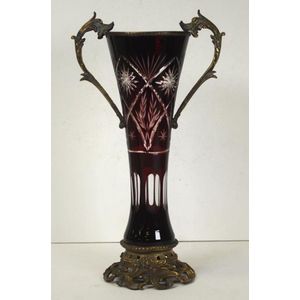Art Nouveau Cranberry Glass Vase with Ormolu Accents
You must be a subscriber, and be logged in to view price and dealer details.
Subscribe Now to view actual auction price for this item
When you subscribe, you have the option of setting the currency in which to display prices to $Au, $US, $NZ or Stg.
- Cranberry Glass - Cranberry glass is a type of glass that is characterized by its deep red color. It was first made in the 19th century and was particularly popular during the Victorian era. It was typically used to make decorative items such as vases and figurines. The red color was achieved by adding gold chloride or selenium to the glass mixture during the manufacturing process.
- Art Nouveau Period - The Art Nouveau period was a cultural movement that emerged in the late 19th century, and was characterized by its emphasis on natural forms, flowing lines, and a decorative, ornamental style. Art Nouveau was a reaction against the ornate and heavily stylized designs of the previous era, and sought to create a new, more organic aesthetic.
Art Nouveau was characterized by its use of sinuous, curving lines, as well as a focus on natural elements such as flowers, vines, and other organic shapes. Art Nouveau designers sought to create a total work of art, in which every element of a building or object was designed to be harmonious with the overall design.
Some of the most iconic examples of Art Nouveau design include the Paris Metro entrances designed by Hector Guimard, the works of the artist Alphonse Mucha, and the architecture of Victor Horta in Brussels.
The Art Nouveau period was at its peak between 1890 and 1910, but began to decline in popularity by the start of World War I. However, Art Nouveau remains an important influence on design and art to this day, and continues to be celebrated for its emphasis on natural forms and decorative style. - Ormolu - Ormolu was popular with French craftsmen in the 18th and 19th century for ornamental fittings for furniture, clocks and other decorative items. True ormolu is gilt bronze, that is bronze that has been coated with gold using a mercury amalgam. Due to the health risks associated with using mercury, this method of creating ormolu was discontinued in France in the 1830s. A substitute was developed consisting of about 75% copper and 25% zinc, however it was inferior to the bronze version. It was often lacquered to prevent it tarnishing.
- Cut Glass - Cut glass is glassware decorated with facets, grooves and depressions of various sizes and shapes, made by cutting into the surface of the glass using a rotating abrasive wheel. The glass is ground so the surface consists of facets, which have a high degree of light refraction, so that the surface sparkles.
The techniques of glass cutting had been known since the 8th century BC, and the practice was revived in Bohemia and Germany in the early part of the 16th century and in England in the 18th century. Cutting became the most common method of decorating glass in the second half of the 18th century and the early 19th century.
This item has been included into following indexes:
- Art Nouveau - glass objects 163
-
Bohemian (Czech Republic) glass wares
- various wares 458
- vases 237
Visually similar items

Chinese export silver dragon vase trumpet shape with spiralling dragon by Tuck Chang, height 23 cm, weight 289g

A Victorian sterling silver octagonal Christening mug by Joseph Angell, London 1863, 10 cm high, 130 grams

Victorian Bristle blue & silver plated wine ewer on a silver plated bottle holder. Height 39 cm

Lovely pair of Art Nouveau twin handled vases, of tapering form, decorated with raised masks of maidens with flowers in hair, above flowing floral motif, flanked by twin handles, height 21 cm
